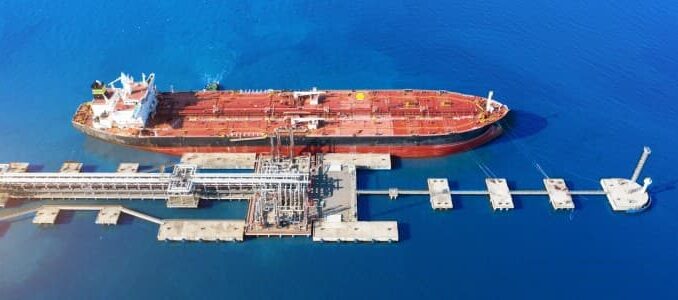
Russia’s oil export machine, a cornerstone of its economy amid ongoing sanctions and geopolitical tensions, is showing signs of strain. Weekly crude exports plummeted to an average of 3.18 million barrels per day (bpd) in the seven days ending September 14, 2025—the sharpest weekly drop since July 2024, down by a staggering 934,000 bpd from the prior period.
The culprit? Intensified Ukrainian drone strikes targeting key Baltic Sea export hubs, which have disrupted flows from major ports like Primorsk and Ust-Luga. While the four-week average held steady at 3.46 million bpd, the latest data underscores how fragile Russia’s export routes have become in the face of escalating sabotage efforts.This comes against the backdrop of a relatively stable year-to-date (YTD) production profile for Russian crude, but with mounting pressures from attacks on refineries and infrastructure that could signal broader supply risks. For energy investors, these developments introduce a volatile mix of geopolitical premiums, potential price upside, and diversification opportunities. Let’s break it down.
Year-to-Date Russian Crude Production: Steady but Under Pressure
Through the first eight months of 2025, Russia’s crude oil production has hovered in the 9.8 to 10 million bpd range, reflecting resilience despite Western sanctions and voluntary OPEC+ cuts. According to recent data, output averaged around 9.818 million bpd in May 2025, dipping slightly from 9.853 million bpd in April, but remaining broadly flat year-over-year.
More recent figures from YCharts show production at 9.853 million bpd in the latest reported month, up modestly from 9.795 million bpd the prior month but down from 10.05 million bpd a year earlier—a 0.6% sequential increase amid efforts to stabilize.
Are you Paying High Taxes in New Jersey, New York, or California?
Analysts expect full-year 2025 production to remain flat at approximately 10.3 million bpd, with a slight uptick to 10.4 million bpd projected for 2026, assuming no major escalations.
This stability is notable given Russia’s pivot to Asian markets—primarily China and India—following the 2022 invasion of Ukraine and subsequent G7 price caps. Seaborne crude exports in June 2025 totaled 24.8 million tonnes (about 5.8 million bpd), down 5% from May, while August saw total oil and fuel exports ease to 7.3 million bpd, with crude specifically falling by 30,000 bpd.
However, these figures mask vulnerabilities exposed by recent disruptions, as production alone doesn’t translate to revenue if export channels are compromised.
Last Month’s Attacks: A Barrage on Refineries and Export Infrastructure
August 2025 marked a ramp-up in Ukrainian drone operations against Russia’s energy sector, with strikes hitting at least 10 refineries and key export terminals. These attacks slashed Russia’s refining capacity by nearly 20% at their peak, affecting facilities with a combined annual processing capacity of about 77 million tonnes.
The targeted infrastructure included ports handling nearly half of Russia’s seaborne crude exports, with over 200 drones deployed in coordinated assaults.
Notable incidents included:
Baltic Sea Terminals: Ukraine struck Russia’s largest oil terminal at Ust-Luga, halving flows there, and hit the Primorsk hub, suspending operations briefly and damaging two tankers. Exports from Primorsk hit their lowest levels since late July.
Strikes also damaged three pumping stations feeding Ust-Luga, exacerbating the bottlenecks.
Refinery Hits: Drones targeted multiple processing plants, contributing to the overall capacity crunch. These facilities are critical for turning crude into exportable products, and the damage has forced Russia to idle units and reroute supplies.
Broader Export Disruptions: Attacks extended to pipelines and shadow fleet tankers, with a quarter of August’s oil deliveries involving sanctioned vessels. This has complicated Russia’s efforts to evade sanctions via “ghost” shipping.
The result? Russia’s oil and fuel export revenue dipped in August, per the International Energy Agency (IEA), as these strikes compounded the effects of Western sanctions.
Sources indicate Moscow is now close to involuntary production cuts, as damaged infrastructure limits output without viable alternatives.
What This Means for Energy Investors
For energy investors, the convergence of steady YTD production with acute export disruptions paints a picture of heightened risk and opportunity in the global oil market. Here’s the breakdown:
Supply Tightness and Price Support: The Baltic strikes alone could shave off significant volumes—potentially 500,000 to 1 million bpd if prolonged—adding a geopolitical risk premium to Brent and WTI benchmarks. Oil prices inched higher on September 16 amid reports of possible Russian output reductions, with crude settling around $64 per barrel.
Investors in non-Russian producers (e.g., US shale, Middle East majors) stand to benefit from any sustained tightness, as Russia’s 7-8% share of global exports faces headwinds. The IEA’s September report forecasts non-OPEC+ growth at 1.4 million bpd in 2025, providing a buffer, but unexpected Russian shortfalls could accelerate price recovery.
Geopolitical and Sanction Risks: Escalating attacks amplify uncertainty for Russian-linked assets, including those traded via India or China. Energy investors should monitor shadow fleet dynamics—53% of August shipments used G7+ tankers, down from July, as sanctions tighten.
Diversification away from Russian exposure is prudent; consider ETFs focused on diversified upstream players or LNG alternatives, as Russia’s pivot strains its logistics.
Longer-Term Opportunities: While short-term volatility favors bulls, Russia’s expected production stability suggests no imminent collapse.
Investors eyeing value plays might look to undervalued Russian bonds or proxies, but with caution—drone warfare has turned energy infrastructure into a frontline target. Broader market resilience, including OPEC+ spare capacity, could cap upside, but any escalation (e.g., more Baltic hits) might push oil toward $70-80/bbl.
In summary, Russia’s crude exports are at a tipping point, with August’s attacks exposing vulnerabilities that YTD production data hasn’t yet reflected. Energy investors should brace for choppy waters: hedge against supply risks, favor resilient producers, and watch for signals from Moscow’s response. As the Ukraine conflict evolves, these disruptions could redefine global energy flows for months to come.
Energy News Beat provides timely insights into the global energy landscape. Follow us for more analysis.
Avoid Paying Taxes in 2025
Crude Oil, LNG, Jet Fuel price quote
ENB Top News
ENB
Energy Dashboard
ENB Podcast
ENB Substack






Be the first to comment